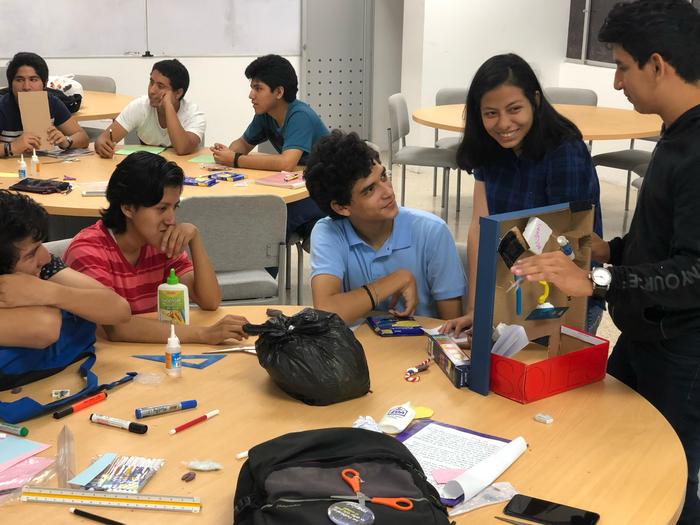Design Thinking is ushering a paradigm shift in how educational institutions equip students with the skills necessary to thrive in today’s complex and rapidly changing world. A groundbreaking study conducted by the Escuela Superior Politécnica del Litoral (ESPOL) in collaboration with Ghent University serves as a crucial blueprint for implementing Design Thinking as a formal course within university curricula. This innovative approach not only emphasizes creative problem-solving and collaborative teamwork but also serves as a vehicle for experiential learning that can be adapted and transferred to various educational contexts.
The study’s primary objective revolves around the integration of Design Thinking into the first-year curriculum of all undergraduate programs at ESPOL. This initiative is rooted in the understanding that fostering essential Design Thinking skills is vital for students navigating a landscape characterized by continual change. Previous research indicates that such a course allows students to create their own knowledge through active engagement, critical thinking, and practical application in real-world scenarios.
From a structural standpoint, this research offers invaluable insights into the course design and implementation of an effective Design Thinking curriculum aimed at higher education settings. In the process, it provides a scalable model that other institutions can replicate to tailor their educational offerings in relation to the needs of today’s workforce. This framework is not static; rather, it can evolve as educational contexts shift, thereby providing contextually relevant methodologies that can enrich learners across diverse fields of study.
Transforming traditional classrooms into dynamic innovation spaces encapsulates the core of the Design Thinking experience at ESPOL. Since its inception, the course has dramatically altered how students engage with academic material and real-world challenges alike. Virtually every semester, around 1,000 students collaborate in multidisciplinary teams, tackling authentic problems posed by external organizations such as non-governmental organizations, small enterprises, and community foundations. This practical engagement not only enhances the educational experience but encourages students to take ownership of their learning journey.
Moreover, the feedback gathered from surveys administered to students at the course’s conclusion reveals a compelling statistic: over 85% of participants reported heightened motivation to apply Design Thinking principles in both academic and professional settings. Simultaneously, collaborating organizations have recognized the tangible benefits of participation, receiving fresh ideas and innovative solutions that can address complex challenges in their operations. This reciprocal relationship highlights the mutual advantages of integrating academic theory with practical application in a real-world context.
Moreover, the success of the Design Thinking course illustrates that imparting complex, 21st-century skills is indeed achievable through a structured and thoughtful pedagogical approach. The combination of hands-on engagement with real-world issues alongside a student-centered methodology forms the foundation of an educational model that other institutions can draw inspiration from. Such strategies are critical for shaping graduates who are not merely consumers of knowledge but active contributors to their fields.
The six-phase Design Thinking process serves as the backbone of the curriculum, carefully guiding students through a comprehensive educational experience designed to foster critical skills. The initial phase, Research, requires students to gather pertinent information necessary for understanding the context of the problem they are tasked with solving. This foundational step is critical, as it anchors subsequent phases in a solid understanding of the issues at hand.
Empathizing with users marks the second phase and encourages students to gain insights into the needs and emotions of others. This pivotal step is essential for fostering solutions that are not only innovative but deeply relevant to end-users, ensuring that the solutions designed resonate on a personal level. The next phase, Define, involves reformulating the problem statement based on the findings from earlier stages, which is crucial for aligning the team’s focus and ensuring that they address the right issues effectively.
Ideation, the fourth phase, invites students to let their creativity flow as they brainstorm a multitude of potential solutions. This phase champions diversity in thought, fostering an environment where all ideas are explored and considered fully, irrespective of their practicality at this initial stage. The subsequent phase, Prototype, encourages students to bring their ideas to life through tangible representations, whether that be through sketches, models, or digital platforms. This hands-on experience is vital for students, as it transforms abstract concepts into realities.
Finally, Validation rounds off the process as students test their prototypes with real users, gathering crucial feedback that informs further iterations of their designs. This cycle of testing and feedback ensures that students are not only honing their problem-solving abilities but are also learning the vital skill of adapting their approaches based on real-world input. Such a student-centered method equips graduates with essential transversal competencies that are increasingly demanded by employers across industries.
The impact of this approach is already well documented, with research demonstrating that pedagogical frameworks aligning with constructivist learning principles significantly enhance student engagement and retention of knowledge. Design Thinking courses, like that offered at ESPOL, stand at the forefront of this educational revolution, empowering students to tackle the challenges of the 21st century head-on. This dedication to practical learning and adaptability shapes a generation poised to innovate and lead across various sectors, significantly benefiting society at large.
This innovative course model not only tests the waters for what education can achieve but also challenges traditional notions about what universities can and should do. As higher education continues to wrestle with its purpose and relevance in a fast-evolving landscape, ESPOL’s Design Thinking course illustrates a path forward—one that integrates theory, practice, and collaboration in a manner that inspires students to become active agents of change within their communities and professions.
Subject of Research: Not applicable
Article Title: How to set up a formal Design Thinking course that works? A practical guide for higher education settings
News Publication Date: 14-Jan-2025
Web References: DOI link
References: Not applicable
Image Credits: Credit: i3lab ESPOL
Keywords: Design Thinking, higher education, experiential learning, student-centered approach, problem-solving, collaboration, innovation, 21st-century skills.




